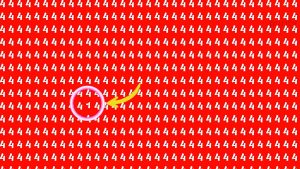Have you ever stared at something so hard your eyes started playing tricks on you? That weird feeling when your brain scrambles to make sense of what you’re seeing isn’t just annoying—it’s actually fascinating. Optical illusions mess with our minds in the most delightful ways.
Today’s challenge is deceptively simple but might leave you scratching your head. Can you locate the hidden number 1 among a jumble of similar-looking characters in just 6 seconds? Many try, but surprisingly few succeed on their first attempt.
What Makes This Illusion So Tricky?
The human brain processes visual information in fascinating ways. When faced with this particular challenge, your mind is simultaneously trying to recognize patterns while also being fooled by them.
Our eyes dart across the image, desperately searching for that elusive number 1. The challenge exploits how our brains naturally group similar objects together, making the hidden digit remarkably difficult to spot within the time limit.
Some people find it immediately, while others might stare for minutes without success. Your personal visual processing style dramatically affects how quickly you can solve this puzzle. No two people see exactly the same way.

The Science Behind Optical Illusions
Optical illusions aren’t just fun party tricks—they reveal profound truths about human perception. They exploit gaps between reality and how our visual systeminterprets what we see.
Your brain doesn’t passively receive images like a camera. Instead, it actively constructs what you perceive, filling in gaps and making assumptions based on past experiences. This incredible shortcut system usually works brilliantly but occasionally gets tripped up.
Scientists have studied these phenomena for centuries, fascinated by what they teach us about the inner workings of the mind. Every time you’re fooled by an illusion, you’re experiencing firsthand how your perception system operates.
Types of Visual Illusions
Not all optical illusions work the same way. Some play with contrast, others with perspective or motion. The hidden number challenge falls into the category of camouflage illusions.
These particular brain-teasers hide objects in plain sight by surrounding them with visually similar elements. Your brain struggles to separate the signal from the noise, especially when under time pressure.
Masters of camouflage in nature—like stick insects or certain octopuses—use the same principles to hide from predators. What’s a game for us is survival for them.
Why the 6-Second Time Limit?
The strict time constraint isn’t just for excitement—it fundamentally changes how your brain approaches the problem. With unlimited time, you’d methodically scan the image until you found the hidden digit.
But with just 6 seconds, your brain switches to a different processing mode. You’re forced to rely on instantaneous pattern recognition rather than systematic searching. This reveals a lot about your intuitive visual processing abilities.
Professional puzzle designers carefully calibrate these time limits to hit the sweet spot between possible and frustrating. Too short and nobody succeeds; too long and the challenge loses its edge.
How to Improve Your Visual Perception
Regular practice with optical illusions and similar puzzles can genuinely sharpen your visual acuity. The brain, like any other part of you, gets better at what it does frequently.
People who solve puzzles regularly often develop specialized neural pathways that help them spot patterns more quickly. This skill transfers surprisingly well to real-world tasks requiring attention to detail.
Even if you struggled with today’s challenge, don’t get discouraged. Visual perception improves with practice, just like any other skill. Tomorrow’s puzzle might be the one where everything suddenly clicks.
Did You Find It Yet?
If you’ve spotted the hidden number 1, congratulations! You’re among the minority with particularly keen visual processing skills. The ability to filter signal from noise quickly is surprisingly rare.
If you’re still searching, try relaxing your gaze slightly. Sometimes focusing too hard actually prevents you from seeing the solution. Let your eyes wander naturally across the image without forcing concentration.
Many successful solvers report that the answer seemed to “pop out” suddenly after they stopped trying so hard. The brain works in mysterious ways, sometimes solving problems when we least expect it.
Beyond the Challenge: Real-World Applications
These aren’t just idle games. The skills tested by optical illusions have practical applications in many fields. Air traffic controllers, radiologists, and security screeners all rely on similar visual discrimination abilities.
People who excel at these puzzles often thrive in professions requiring sustained attention and the ability to detect subtle patterns. Your puzzle-solving prowess might hint at untapped professional talents.
Even driving safely requires quickly spotting important details in a complex visual field. The same neural mechanisms that help you find the hidden number also help you notice that child about to run into the street.
Why We Love Being Fooled
There’s something deeply satisfying about optical illusions, even when they frustrate us. The moment of revelation—when you finally see what was hiding in plain sight—delivers a genuine dopamine hit.
This pleasure response keeps us coming back for more puzzles, more challenges, more opportunities to test ourselves against our own perception. It’s learning disguised as entertainment.
Cultural fascination with illusions spans centuries and civilizations. From ancient architectural tricks to modern digital animations, humans have always enjoyed playing with the boundaries of perception.

Share Your Experience
Did you spot the hidden 1 within the time limit? How long did it actually take you? Everyone’s experience with this illusion differs slightly based on countless individual factors.
Some report seeing it instantly, while others need hints or extra time. Neither experience is wrong—just different ways our unique brains process visual information.
Sharing these puzzles with friends often leads to fascinating conversations about perception. You might be surprised how differently someone else experienced the exact same image.
Frequently Asked Questions
Why can some people solve optical illusions faster than others? Individual differences in visual processing, attention patterns, and previous experience all play roles in how quickly someone can solve visual puzzles.
Can you train yourself to get better at these challenges? Yes! Regular practice with various optical illusions and visual puzzles improves pattern recognition and visual discrimination skills over time.
Are optical illusions just tricks, or do they have scientific value? They have genuine scientific importance, helping researchers understand visual processing pathways in the brain and how perception works.
Why do our brains get fooled by optical illusions? Our visual system makes assumptions based on limited information and past experiences, which usually works well but can be exploited by carefully designed illusions.
Do optical illusions work the same way for everyone? No—cultural background, age, experience, and even mood can affect how individuals perceive and process optical illusions.
So, did you manage to find the hidden number 1 within the 6-second time limit? Whether you succeeded or need a bit more practice, these visual challenges offer fascinating insights into how our brains make sense of the world around us. Keep challenging yourself—your perception might surprise you!
